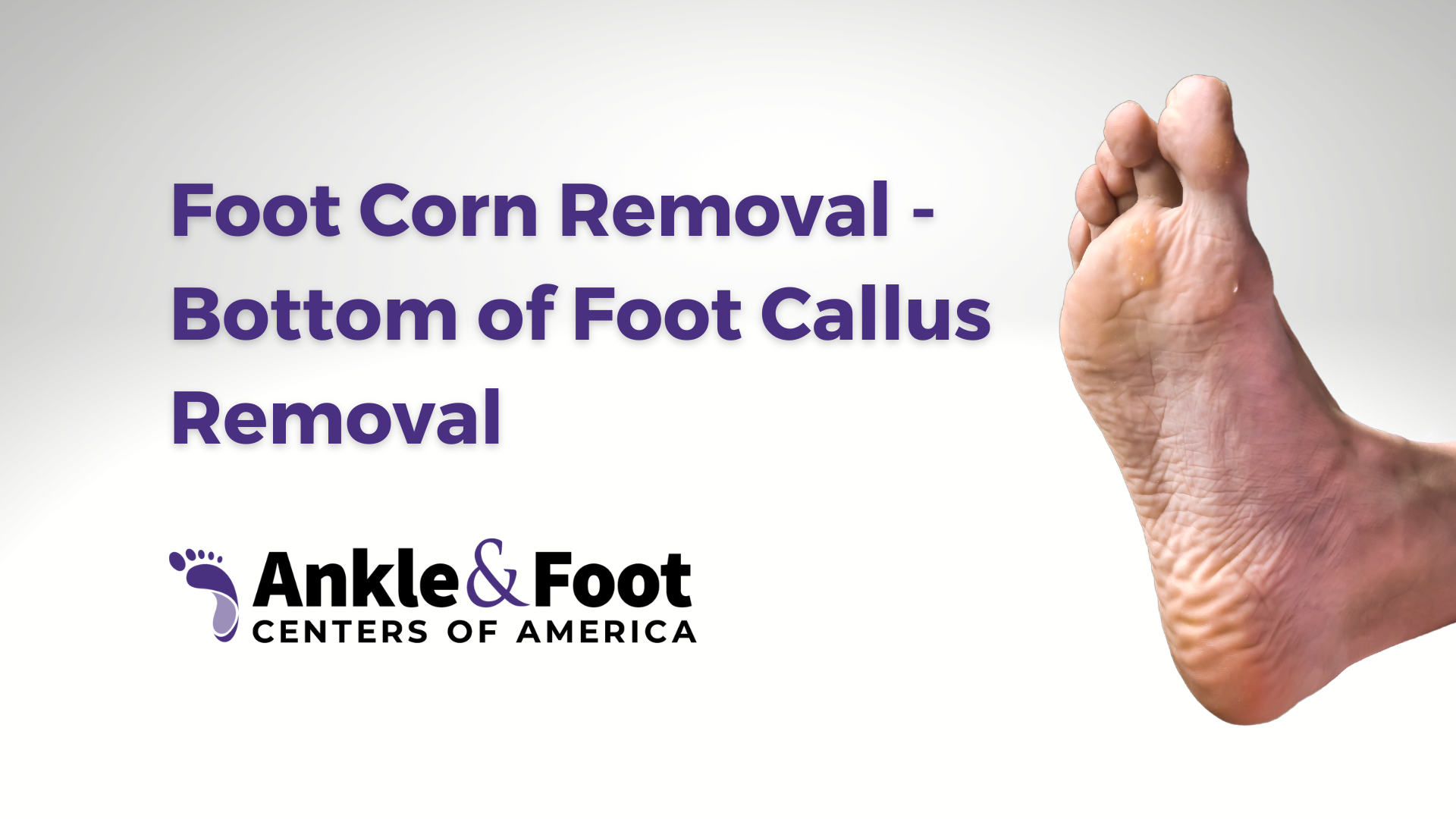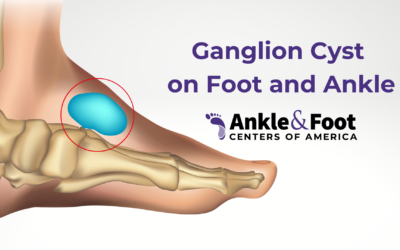Foot health is an often overlooked aspect of our overall well-being. However, anyone who has experienced the discomfort of a foot corn knows just how crucial it is to maintain healthy feet. This guide delves deep into the world of foot corns, offering insights into their causes, prevention, and treatment. By understanding and addressing foot corns, you can take a step towards pain-free mobility and improved foot health.
What are Foot Corns?
Foot corns are thickened areas of skin that develop in response to excessive pressure and friction. They form to protect the skin and the structures beneath it from injury or damage. Corns can be hard or soft, depending on their location and the type of pressure causing them. Hard corns typically develop on the tops and sides of the toes, while soft corns form between the toes and remain softer due to the moisture from sweat.
Causes and Common Locations on the Foot
The primary cause of foot corns is repeated friction and pressure, typically from shoes that don’t fit properly. When footwear is too tight, it can squeeze the foot, leading to corns. Conversely, shoes that are too loose can cause the foot to slide and rub against the shoe. High heels, which place excessive pressure on the front of the foot, are also common culprits.
Other causes include:
- Foot deformities such as hammertoes or bunions, which can lead to increased pressure on certain areas of the foot.
- Not wearing socks, which increases friction between the foot and the shoe.
- Engaging in activities that put increased pressure on the foot, such as running or hiking.
Symptoms of Foot Corns
Physical Appearance
Corns are usually round and have a yellowish color. They can be surrounded by inflamed skin and might feel rough to the touch. The center, which is the most thickened area, can be tender or painful when pressed.
Pain and Discomfort
While some corns may be painless, others can cause significant discomfort, especially when pressure is applied. The pain usually intensifies when wearing shoes or walking. Soft corns, due to their location between the toes, can become painful more quickly than hard corns.
Differences between Corns and Calluses
Both corns and calluses are thickened patches of skin caused by friction and pressure. However, they differ in their locations and appearances. Calluses are usually larger, broader, and appear on the soles of the feet, while corns are smaller, have a distinct edge, and often form on or between the toes.
Common Causes and Risk Factors
Foot corns, though small, can cause significant discomfort. Understanding the root causes and risk factors can help in preventing their formation and addressing the issue effectively.
Ill-fitting Shoes
The Role of Footwear
One of the primary culprits behind the development of foot corns is ill-fitting footwear. Shoes that don’t fit properly can create areas of excessive pressure and friction on the foot, leading to the formation of corns.
Tight Shoes
Shoes that are too tight, especially in the toe area, can squeeze the toes together. This not only causes friction between the toes but also pushes the toes against the shoe, leading to the development of corns on the tops and sides of the toes.
Loose Shoes
On the other hand, shoes that are too loose can cause the foot to slide inside, creating friction as the foot rubs against the shoe. This can lead to corns on the soles of the feet.
Foot Deformities
Hammertoes and Bunions
Foot deformities such as hammertoes (where the toe bends downward) and bunions (a bony bump that forms on the joint at the base of the big toe) can lead to increased pressure on certain areas of the foot. This abnormal pressure can result in corn formation, especially if the deformity causes the foot to rub against the shoe.
Other Deformities
Other foot deformities, such as bone spurs or misaligned bones, can also create pressure points that may lead to corns.
Repetitive Actions or Pressure
Activities and Occupations
Certain activities or occupations that involve repetitive motions or place increased pressure on the feet can contribute to corn development. For instance, athletes, dancers, or individuals who are on their feet for extended periods may be more prone to corns.
External Pressure Sources
Walking or standing on hard surfaces for prolonged durations, or using tools and equipment that exert pressure on the feet, can also be contributing factors.
Aging and Skin Changes
As we age, the skin loses its elasticity and becomes less supple. This can make it more susceptible to damage from friction and pressure. Additionally, the natural padding of fat on the soles of the feet can thin out over time, reducing the cushioning and increasing the risk of corns.
Prevention Tips
Understanding these causes and risk factors is essential for prevention. By choosing the right footwear, addressing foot deformities, being mindful of repetitive pressures, and taking care of the skin, one can significantly reduce the risk of developing foot corns.
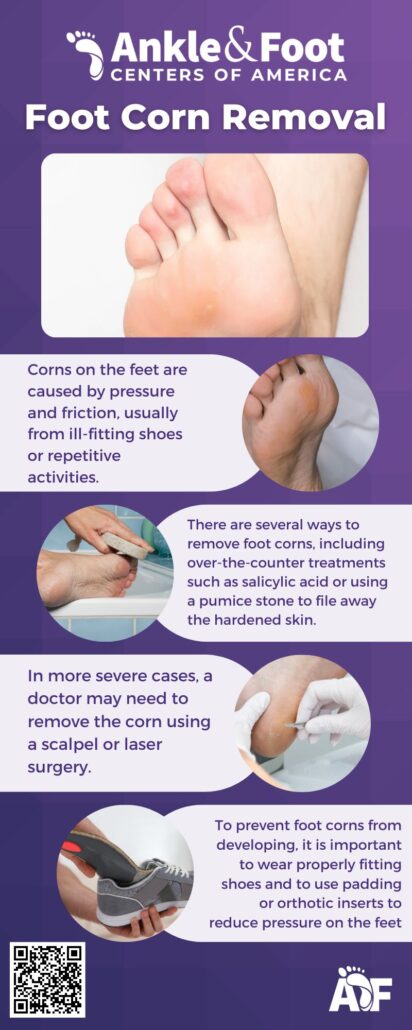 Prevention Tips
Prevention Tips
Preventing foot corns is not only about ensuring comfort but also about promoting overall foot health. By adopting certain habits and being mindful of footwear choices, one can effectively reduce the risk of developing these painful skin formations.
Choosing the Right Footwear
Importance of Proper Fit
Footwear plays a pivotal role in foot health. Shoes that fit well can prevent a multitude of foot issues, including corns. It’s essential to ensure that shoes provide enough room for the toes to move freely without squeezing or pressing against each other or the shoe itself.
Trying Before Buying
Always try on shoes before purchasing. Walk around in them to gauge comfort levels. The best time to shop for shoes is later in the day when feet are at their largest due to natural swelling.
Prioritizing Comfort Over Fashion
While it’s tempting to buy shoes based solely on their aesthetic appeal, it’s crucial to prioritize comfort. High heels or shoes with pointed toes might look stylish but can be detrimental to foot health.
Proper Foot Hygiene
Regular Cleaning
Washing feet daily with soap and water helps remove dirt and sweat, reducing the chances of friction. Ensure to dry feet thoroughly, especially between the toes, to prevent soft corns from forming due to moisture.
Moisturizing
Applying a good foot cream or moisturizer can keep the skin supple, reducing the risk of corns and calluses. However, avoid applying creams between the toes to prevent moisture buildup.
Using Protective Pads or Cushions
Benefits of Padding
Using protective pads, cushions, or insoles can help distribute pressure evenly across the foot, reducing the risk of corns. They act as a barrier, minimizing friction between the foot and the shoe.
Types of Pads
There are various types of pads available, such as toe separators, corn cushions, and metatarsal pads. Choose one that best suits your needs and ensures comfort.
Regular Foot Check-ups
Self-examination
Regularly inspect your feet for any signs of corns, calluses, or other foot issues. Early detection can lead to quicker and simpler treatments.
Professional Consultation
If you’re prone to foot problems or have underlying health conditions like diabetes, it’s advisable to have regular check-ups with a podiatrist. They can provide guidance on foot care and recommend suitable footwear or orthotic devices.
Home Remedies for Corn Removal
While foot corns can be bothersome, there are several home remedies that can help alleviate the discomfort and promote healing. These remedies focus on softening the corn, reducing friction, and gradually eliminating the thickened skin.
Soaking and Exfoliation
Benefits of Soaking
Soaking the feet in warm water can help soften the corn, making it easier to remove. The warm water relaxes the feet, increases blood circulation, and prepares the skin for exfoliation.
How to Soak
Fill a basin with warm water and add a tablespoon of Epsom salt or baking soda. Immerse your feet for about 10-15 minutes. You can also add a few drops of essential oils like lavender or tea tree for added relaxation and antiseptic properties.
Exfoliation Post Soak
After soaking, use a pumice stone or foot file to gently rub the corn. This process helps in removing the dead skin layers. Ensure you use gentle, circular motions to avoid causing any injury.
Over-the-counter Corn Removal Products
Salicylic Acid Patches
These patches contain salicylic acid, which helps in breaking down the dead skin of the corn. Place the patch over the corn, ensuring the corn is centered over the medicated area. Use as directed.
Corn Caps
Similar to patches, corn caps contain medication that aids in corn removal. They also provide cushioning, reducing pressure on the corn.
Liquid Corn Removers
These are solutions that can be applied directly to the corn using a brush or applicator. They usually contain salicylic acid and should be used as per the instructions.
Natural Remedies and Their Effectiveness
Pineapple Peel
The enzymes in pineapple peel can help soften corns. Place a piece of pineapple peel over the corn with the inner part touching the skin. Secure it with a bandage overnight.
Lemon and Clove Oil
The acidity of lemon combined with the analgesic properties of clove oil can help in corn removal. Apply a mixture of lemon juice and a few drops of clove oil to the corn and cover it with a bandage.
Turmeric and Honey
Both turmeric and honey have anti-inflammatory properties. Make a paste with turmeric powder and honey and apply it to the corn. Cover with a bandage and leave it overnight.
Garlic
Garlic has antioxidant and antimicrobial properties. Rub a garlic clove on the corn and then secure a slice of garlic over it using a bandage. Leave it overnight and wash it off in the morning.
Precautions with Home Remedies
While home remedies can be effective, it’s essential to monitor the skin for any signs of irritation or allergic reactions. If the corn becomes painful, inflamed, or shows signs of infection, discontinue the remedy and consult a healthcare professional. Additionally, individuals with diabetes or poor circulation should be cautious and consult a doctor before trying any home treatments.
Medical Treatments
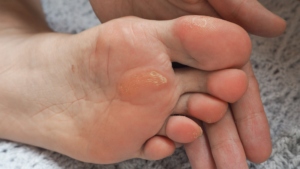 While home remedies can be effective for many, there are instances where medical intervention becomes necessary for corn removal. Medical treatments are especially recommended for those with underlying health conditions, such as diabetes, or for persistent corns that don’t respond to home treatments.
While home remedies can be effective for many, there are instances where medical intervention becomes necessary for corn removal. Medical treatments are especially recommended for those with underlying health conditions, such as diabetes, or for persistent corns that don’t respond to home treatments.
Over-the-counter Treatments
Salicylic Acid Patches
These are adhesive patches infused with salicylic acid, a keratolytic agent that helps break down the tough skin of the corn. By wearing the patch over the corn, the medication gradually softens and dissolves the corn. It’s essential to follow the product’s instructions and ensure the surrounding skin is protected from the acid.
Corn Caps
Corn caps are similar to salicylic acid patches but come with added cushioning. This cushioning helps reduce pressure on the corn, providing relief from pain while the medication works on the corn.
Professional Corn Shaving by a Podiatrist
The Procedure
A podiatrist or foot doctor can perform a procedure known as corn shaving or debridement. Using a scalpel, the doctor carefully trims away the thickened skin of the corn. This procedure is usually painless as it only involves removing dead skin.
Benefits
Corn shaving provides immediate relief, especially for painful corns. It also reduces the size of the corn, making it less prone to pressure and friction.
Cortisone Injections
Purpose of Injections
For corns that are particularly painful due to inflammation or nerve irritation, a cortisone injection can be administered. Cortisone is a steroid that reduces inflammation and pain.
Procedure
The injection is given directly into or near the corn. It’s a quick procedure, but the area might be numbed beforehand to ensure comfort.
Surgical Options and When They’re Necessary
Indications for Surgery
Surgery is considered a last-resort option and is usually recommended for recurrent corns caused by an underlying bone deformity. By addressing the bone issue, the pressure leading to the corn’s formation is eliminated.
Types of Surgery
- Bone Surgery: This involves shaving off a part of the bone that’s causing pressure and leading to corn formation.
- Joint Surgery: In cases where a joint deformity, like hammertoe, is causing the corn, the joint may be realigned or fused to prevent corn recurrence.
Recovery
Post-surgery, patients might need to wear special footwear or orthotics to protect the foot and allow it to heal. Physical therapy exercises might also be recommended to restore foot function.
Precautions with Medical Treatments
While medical treatments are effective, it’s essential to follow post-treatment care instructions diligently. Keeping the area clean, avoiding excessive pressure, and monitoring for signs of infection are crucial. It’s also vital to address the root cause of the corn, such as ill-fitting footwear, to prevent recurrence.
Potential Complications
Foot corns, while often benign, can lead to complications if not addressed properly or if treated inappropriately. Recognizing these potential issues and understanding their implications is crucial for ensuring foot health and avoiding further problems.
Risks of DIY Corn Removal
Infections
Attempting to cut or shave off a corn at home using non-sterile tools can introduce bacteria into the skin, leading to infections. Infections can manifest as increased redness, swelling, pus, and pain around the corn.
Skin Damage
Using over-the-counter treatments or home remedies without proper knowledge can result in skin burns, especially if products containing salicylic acid are misused. This can lead to painful sores and potential scarring.
Aggravation of the Corn
Incorrectly using corn removal products or tools can exacerbate the corn, making it more painful and harder to treat in the future.
Infections and Their Implications
Diabetic Foot
For individuals with diabetes, even a minor foot injury can lead to severe complications. Reduced blood flow and nerve damage, common in diabetes, can delay wound healing and increase the risk of infections. A seemingly harmless corn can escalate into a non-healing ulcer if not treated appropriately.
Cellulitis
If an infection from a corn spreads to the deeper layers of the skin, it can lead to cellulitis. This condition is characterized by red, swollen, and warm skin and can be accompanied by fever. Cellulitis requires prompt medical attention and often treatment with antibiotics.
Importance of Care for Individuals with Diabetes
Regular Foot Checks
People with diabetes should inspect their feet daily for any abnormalities, including corns, calluses, cuts, or sores. Early detection and intervention can prevent complications.
Professional Care
Instead of attempting home treatments, individuals with diabetes are advised to seek professional care for foot corns. A podiatrist or foot specialist can provide safe and effective treatments tailored to their specific needs.
Moisturization and Footwear
Keeping the feet moisturized can prevent skin from drying and cracking, reducing the risk of corns and other foot issues. Additionally, wearing well-fitted, comfortable shoes can prevent excessive friction and pressure that lead to corn formation.
Precautions with Over-the-counter Products
Always read and follow the instructions provided with over-the-counter corn removal products. If any signs of skin irritation or allergic reactions occur, such as itching, redness, or swelling, discontinue use and consult a healthcare professional.
Recovery and Aftercare
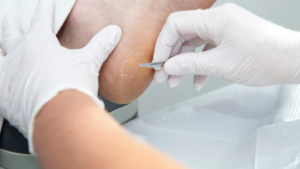 After undergoing treatment for foot corns, whether through home remedies, over-the-counter products, or medical procedures, proper aftercare is crucial. This ensures not only the healing of the treated area but also the prevention of future corns.
After undergoing treatment for foot corns, whether through home remedies, over-the-counter products, or medical procedures, proper aftercare is crucial. This ensures not only the healing of the treated area but also the prevention of future corns.
Post-treatment Care for Surgical Removal
Wound Care
- Cleaning: Keep the treated area clean to prevent infections. Gently wash with mild soap and water, and pat dry.
- Dressing: Depending on the procedure, your doctor might recommend a specific type of dressing or bandage. Ensure it’s changed regularly and kept dry.
Medications
- Pain Management: Over-the-counter pain relievers, such as ibuprofen or acetaminophen, can help manage discomfort post-surgery. Always use as directed and consult with your doctor about any potential interactions with other medications.
- Antibiotics: If there’s a risk of infection, your doctor might prescribe antibiotics. Ensure you complete the entire course, even if symptoms improve.
Activity Restrictions
- Rest: Give your foot ample time to heal. Avoid putting unnecessary pressure on the treated area.
- Footwear: Wear soft, cushioned, and comfortable shoes that don’t squeeze or rub against the healing area. Avoid high heels or tight shoes.
Tips to Prevent Recurrence
Footwear Choices
- Fit: Always choose shoes that fit well. There should be enough space for your toes to move without being squeezed.
- Material: Opt for shoes made of natural materials like leather, which allow the feet to breathe and reduce moisture buildup.
Foot Hygiene
- Regular Cleaning: Wash your feet daily, ensuring you dry them thoroughly, especially between the toes.
- Moisturize: Apply a foot cream or moisturizer to keep the skin soft, but avoid the areas between the toes to prevent moisture accumulation.
Protective Measures
- Pads and Cushions: If you’re prone to corns, consider using protective pads or cushions in areas of friction or pressure.
- Orthotics: Custom-made orthotics can help redistribute pressure on the foot, reducing the risk of corns.
When to See a Foot Doctor
It’s essential to monitor the healing process and be aware of signs that might indicate complications. If you notice increased redness, swelling, pus, or if the pain worsens, it’s crucial to seek medical attention. Additionally, if the corn recurs frequently in the same spot, it might indicate an underlying issue that needs to be addressed.
Conclusion
Foot corns, though small, can significantly impact one’s daily life, causing discomfort and pain. However, with the right knowledge and proactive measures, they can be effectively managed and prevented.
Recap of the Importance of Addressing Foot Corns
Not Just a Cosmetic Concern
While corns might seem like a mere aesthetic issue, they are a sign of underlying friction and pressure on the foot. Addressing them is not just about improving appearance but ensuring foot health and comfort.
Potential for Complications
As discussed, untreated corns or improperly treated ones can lead to complications, especially for individuals with underlying health conditions. Recognizing and addressing corns early can prevent these complications.
Encouragement for Proactive Foot Care
Regular Foot Inspections
Make it a habit to inspect your feet regularly. Look out for any signs of corns, calluses, or other foot issues. Early detection often means simpler and more effective treatments.
Invest in Foot Health
From choosing the right footwear to maintaining foot hygiene, investing time and effort in foot health can prevent a range of issues, including corns. Remember, your feet carry you everywhere; they deserve care and attention.
Seek Expert Advice
If in doubt, always seek expert advice. Whether it’s choosing over-the-counter treatments or considering surgical options, a healthcare professional or podiatrist can provide guidance tailored to your specific needs.

